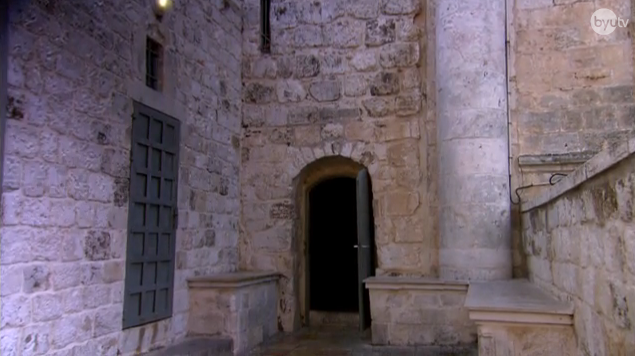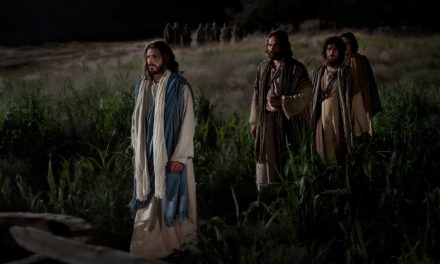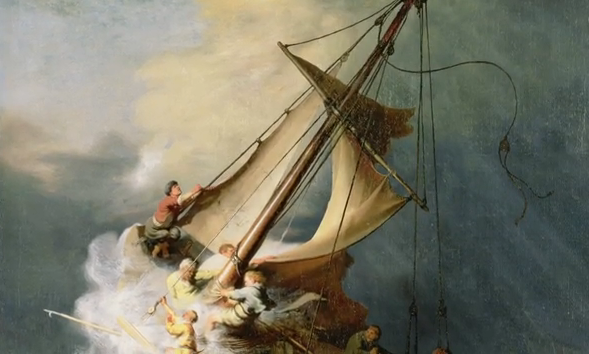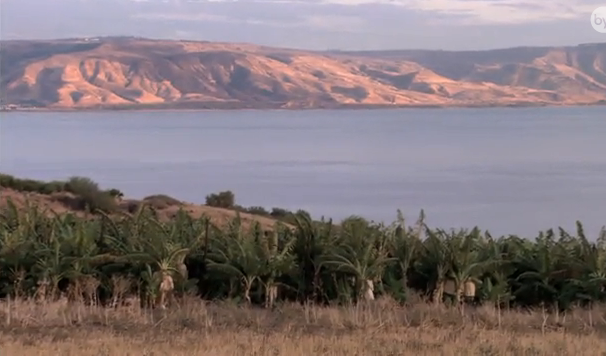MARCUS H. MARTINS: And they are in tears. Nobody’s saying a word, but they are in tears. And He perceives, as only a God can do, that they want him to stay a little longer with them. They want Him to do the miracles that —they would expect Him to do.
JOHN W. WELCH: He says, I was going to leave, but let’s stay and do some more. Here in Bountiful, even the lame and the blind were there. An extraordinary event, an accident if you will. They didn’t know He was going to be there. But of their own free will they had come that day, summoned to the temple, wanting to know what they should do next. He called them forward, and had them come up, there at the temple. Now they didn’t put people’s names on a prayer roll, they had them come right to the temple, front and center, and Jesus healed them one by one (see 3 Nephi 17:5–9).
MARCUS H. MARTINS: He asked the multitude to bring their children to Him. And so the multitude opens, you know, a little circle around the Savior. They bring all their children, and they place the children at Jesus’s feet.
JOHN W. WELCH: Jesus then—and this is often overlooked—offered a very solemn prayer on behalf of the parents. And words cannot express what it was that He prayed in their behalf (see 3 Nephi 17:21).
MARCUS H. MARTINS: He prays using marvelous words, we’re told, such beautiful words, such majestic and powerful words, that the words of His prayer could not even be written. And after that, He weeps. Which is a very interesting reaction from a resurrected being, a member of the Godhead. Here is the God of Israel, the God of the whole earth, and He is weeping. And He says it is because of the faith of the people. And then He takes the children, blesses them one by one again, and after He finishes blessing the children, He tells the multitude to behold their little ones. And then as they do that, the heavens open, and angels come from heaven, glorified beings, and they circle the little children and minister to those children (see 3 Nephi 17:20–23).
And the multitude saw this. Mormon doesn’t tell us if they could hear what the angels were ministering to the Christ, but what we know is that two days later, on the third day of the Savior’s visit among the, the Nephites and the Lamanites, He opened the mouth of the little children. Even babies spoke, and they spoke, according to Mormon, marvelous words. And they said that it was such great words that they taught—and it’s very significant also that the children told those words to their parents, instead of to their fathers. And the words were so marvelous that they could not be written. And Mormon specifically states that even babies open their mouth (see 3 Nephi 26:16).
Now, I don’t know if they had any—it was an effect of the ministering of those angels, but it certainly shows that in the kingdom of God, children are not an afterthought. They are not second-class citizens. They are at the center of miracles and great words. It’s a very touching scene, and it gives us a little bit of insight about what goes on in the Savior’s heart when He considers the faith and the purity of His people.
 MONTE NYMAN: This is probably one of the favorite chapters of many people as they read the Book of Mormon. It shows His love and respect for the little ones, and how we too must have love and respect for them. The enormous responsibility we have as fathers, mothers in Israel, this 17th chapter might be an epitome of the love that Jesus has for us as His children, whom He adopts spiritually, as we learn in Mosiah 5 and 7, as His children, if we will come unto him.
MONTE NYMAN: This is probably one of the favorite chapters of many people as they read the Book of Mormon. It shows His love and respect for the little ones, and how we too must have love and respect for them. The enormous responsibility we have as fathers, mothers in Israel, this 17th chapter might be an epitome of the love that Jesus has for us as His children, whom He adopts spiritually, as we learn in Mosiah 5 and 7, as His children, if we will come unto him.
JOHN W. WELCH: He had children brought to him. In the Old World and in the New. Because it is only if we become as little children that we can put off the natural man and have the atoning blood of Christ fully effective in our lives.
KENT BROWN: For those who don’t believe in a physical Resurrection, they really have to stand against this wall of witnesses that comes against them. People who say, “We saw him.” And it seems to me that it’s almost an impossible job. You really do have to be dishonest to the texts, dishonest to the records that are there in front of us.
JOHN S. TANNER: I see this as a story of growth. It’s a story of change. We see apostles who had been fearful when Jesus was arrested, but who become emboldened, and will go to the whole world.
JUAN HENDERSON: When He came, He appeared to the apostles. He told them that they were to wait for the Comforter, or the promise of the Father that would come upon them, before they would actually start their mortal ministry. And so the apostles were gathered together in the Upper Room. They heard the sound of a rushing mighty wind come upon them (see Acts 2:2). The Spirit of the Lord descended upon them, and then after that, they went out and they—Peter preached a powerful sermon on the risen Lord, and that how they all needed to repent and come unto him (see Acts 2:14–39).
JOSEPH FIELDING MCCONKIE: Every time they bear their testimony, they bear testimony to two things. One is the, the fact that Jesus was the Suffering Servant, that He had to die. They have to explain the cross. And now they’ve got confidence in that message. And the other is the reality of His Resurrection. They are competent witnesses. The whole paradigm of how you teach the gospel grows out of this.
JUAN HENDERSON: Peter and John went into the temple. And there was a man that was on the stairway there, and he was lame from birth. And he was asking alms of people that were going in. And he stood—he laid there daily. And then he asked alms of Peter, and then Peter said, “Silver and gold have I none; but such as I have give I thee: In the name of Jesus Christ . . . rise up and walk” (Acts 3:6). And Peter reached forth his hand, as if to know it was done, and he pulled him by the hand and pulled him up. And all of his bones in his legs and feet straighten up, and he began to leap for joy at the miracle that had been performed. You couldn’t do that unless you knew the power source that was in you at that time.
JOSEPH FIELDING MCCONKIE: So now here’s Peter, and the position he’s in is he goes out and he teaches, and he says, I testify to you that Jesus is the Christ. And these are the hands that I placed in the wounds in His side, and with which I embraced him. And I’m here to testify to you that it was real, that I embraced the resurrected Christ as I had embraced him in His ministry, and I know him. These are the hands that felt, these are the eyes that saw, and these are the ears that heard (see . And so this becomes so profound. It becomes so real. It is the power that is in their testimony. It’s the realness of it. And then this event becomes the best attested event in all of earth’s history, as far as support things are concerned.
KENT BROWN: We saw him. We saw him, and, and we touched him. We have seen him eat. We have, we have embraced him. There’s something physical and palpable and inviting in all of this, to all of us, that, that Jesus is real. He’s alive. And that’s my witness, that He is alive, that He lives today.
GAYE STRATHEARN: Paul’s words to the Corinthian saints encapsulates the renewed hope that burns in the hearts of the early disciples. In the two Marys and Salome when they discover the stone has been rolled away, in Peter and John when they rush to the tomb and find it empty, and in the hearts of millions the world over when on that morning the angel utters perhaps the most important words in all of history. “He is not here: for he is risen” (Matthew 28:6).
The Resurrection of Jesus Christ, as attested by disciples in the Old World, is also confirmed by thousands of witnesses in the New World. Each testifies of the Savior’s triumph over death as they touch His wounds and are blessed, one by one, by hands still bearing the marks of the crucifixion. As the Christian world awaits His Second Coming, each of us is left to contemplate the day when we too will meet the Risen Savior—the day when every knee shall bow, and every tongue confess that Jesus is the Christ.








